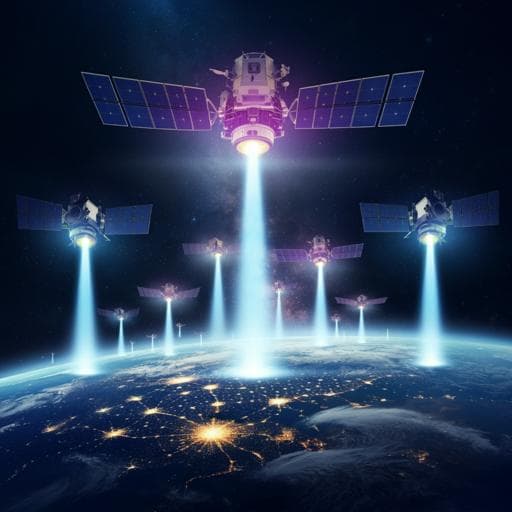
Physics
Spooky action at a global distance: analysis of space-based entanglement distribution for the quantum internet
S. Khatri, A. J. Brady, et al.
Explore the cutting-edge advances in quantum communication with groundbreaking research by Sumeet Khatri, Anthony J. Brady, Renée A. Desporte, Manon P. Bart, and Jonathan P. Dowling. This study unveils a global quantum internet powered by satellites, ensuring continuous entanglement distribution to ground stations. Discover the balance between satellite numbers and entanglement rates and how this transforms the future of quantum technology.
~3 min • Beginner • English
Introduction
The paper addresses how to realize a global-scale quantum internet capable of distributing entanglement for tasks such as QKD, teleportation, clock synchronization, distributed computation, and sensing. Ground-based transmission over atmosphere or fiber suffers exponential loss with distance, and current quantum memories do not support long-distance, high-rate repeater operations. The authors propose a satellite-based solution: a constellation of polar-orbit satellites distributing entangled photon pairs to ground stations, which can then extend links via entanglement swapping. The research questions include: how many satellites and at what altitudes are needed for continuous coverage; what entanglement-distribution rates are achievable between distant ground stations; and how these rates compare with ground-based quantum repeater schemes. The work aims to balance cost (number of satellites) and performance (rates/loss), offering design guidance for near-term, viable global quantum networking.
Literature Review
The paper situates the work within prior advances in QKD and the emerging vision of a quantum internet. It reviews limitations of ground-based links and quantum repeaters, noting resource-intensive proposals and limited experimental scaling. Satellites are highlighted as advantageous for free-space propagation with lower loss and as untrusted nodes for long-distance QKD. Prior proposals considered satellite-to-ground, ground-to-satellite, and hybrid links, often with limited node counts. Earlier constellation analyses include equatorial orbits and trusted-node QKD networks; however, dynamic simulations with polar-orbit constellations and optimization over configurations for continuous coverage had not been comprehensively explored. The work extends these by modeling multiple arbitrarily located ground stations and optimizing polar-orbit constellations.
Methodology
Architecture: A Walker-star-like constellation with N_R equally spaced polar-orbit rings, each containing N_S equally spaced satellites, all at altitude h. Satellites serve as downlink sources of polarization-entangled photon pairs to line-of-sight ground stations; ground stations can act as repeaters via entanglement swapping/purification once elementary links are established. Uplinks are excluded due to higher loss.
Simulations: 24-hour dynamic simulations assess continuous coverage between two equatorial ground stations separated by distance d (100–5000 km), and extended scenarios with multiple ground stations and major city pairs. Satellite configurations span 20–400 satellites (varied N_R, N_S) and altitudes 500–10,000 km. Continuous coverage requires both stations simultaneously in view of at least one satellite at all times, with instantaneous total two-photon downlink loss < 90 dB. Clear-sky conditions are assumed (no clouds/rain/haze); atmospheric turbulence effects are neglected, and background photon noise is analyzed separately.
Assignment policy: At any time, each satellite can serve only one ground-station pair (single onboard source assumption). If multiple pairs are in range, the assignment selects the pair with lowest loss; an exception prioritizes a pair that has only one satellite in view.
Figures of merit and optimization: For given (h,d), N_opt(h,d) is the minimum total satellites achieving continuous 24-hour coverage. R(N_R,N_S,h,d) is the average 24-hour entanglement-distribution rate (simple, single-mode transmission, no multimode memories). The primary figure of merit is c = R/(N_R N_S), i.e., average ebits/s per satellite, and C(h,d) is its maximum over (N_R,N_S) under the coverage and <90 dB constraints. Also considered is R_opt(h,d), the maximum average rate over configurations (often achieved by the largest constellation considered, N_R = N_S = 20). Extensions define analogous metrics for multiple ground-station graphs.
Loss model: Downlink channel modeled as a bosonic pure-loss channel with transmittance η_sg = η_fs η_atm. Free-space transmittance for a Gaussian mode with receive aperture radius r and beam waist w(L): η_fs(L) = 1 − exp(−2 r^2 / w(L)^2), with w(L) = w_0 sqrt(1 + (L/L_R)^2), L_R = π w_0^2 / λ. Atmospheric transmittance modeled via Beer-Lambert law for small zenith angles: η_atm = (η_atm)_zen^{sec ζ} if |ζ| ≤ ζ_c, else 0, with geometry relating ζ to altitude h and slant range. Parameters used: r = 0.75 m, w_0 = 2.5 cm, λ = 810 nm, η_atm at zenith ≈ 0.5 at 810 nm. Turbulence-induced broadening/wandering and path elongation at large ζ are neglected; η_atm set to 0 beyond horizon/large zenith angles.
Noise model and fidelity: Background photons modeled as a low-brightness thermal state per polarization mode mixing via beamsplitters with the signal; post-selection on two-photon coincidences is assumed in high-loss, low-noise regime. Derived conditional output fidelity for ideal Bell-state input under symmetric downlinks depends on local SNR. For target fidelity F*, the required local SNR satisfies approximately SNR ≥ 1/(2 sqrt(1−F*)). For F* = 0.99 and typical η_sg ~ 10^-3, this implies background photons per detection window ≤ 7×10^-2. Background photon rate R estimated from spectral irradiance H: R = (H Ω_fov π r^2 Δλ) / (hc/λ), with example parameters λ = 810 nm, Δλ = 1 nm, Ω_fov = 100 μsr, r = 0.5 m, coincidence window ΔT = 1 ns, used to map fidelity versus H and indicate nighttime feasibility for longer separations under chosen filters.
Rate assumptions: In rate plots (e.g., Figs. 4–6), the source rate is taken as R_source = 10^10 ebits/s to illustrate achievable downlink rates under the loss model. The Monte Carlo sampling in the Methods uses R_source = 10^6 ebits/s per satellite for per-time-step binomial sampling.
Quantum repeater comparison: A ground-based repeater chain of total length d with M elementary links and N_mem quantum memories per half-node is analyzed under best-case assumptions (perfect Bell-pair sources, deterministic swapping, perfect read-write, infinite memory coherence). The expected waiting time W_M,N_mem leads to a rate R_M,N_mem = (C N_mem) / [2(d/M) W_M,N_mem], where C accounts for classical signaling; comparisons consider N_mem = 50 and M ∈ {10,20,50}.
Key Findings
- Optimal satellite count vs altitude: For continuous equatorial two-station coverage, the total number of satellites generally decreases with altitude up to a minimum around 5000–6000 km and then increases; however, at these higher altitudes the average entanglement rates are low (order 10 ebits/s with the assumed source rate in that analysis).
- Primary figure of merit (C = ebits/s per satellite): For each ground separation d there exists an optimal altitude h* and constellation (N_R,N_S) maximizing C(h,d), subject to continuous coverage and instantaneous loss < 90 dB. Table of optima (averages over 24 h, R_source = 10^10 ebits/s in the associated plots):
• d = 1500 km: h* = 1000 km; N_R = 7, N_S = 13; average loss ≈ 62.80 dB; average rate ≈ 1321.32 ebits/s.
• d = 2500 km: h* = 1500 km; N_R = 7, N_S = 13; average loss ≈ 66.86 dB; average rate ≈ 289.07 ebits/s.
• d = 3500 km: h* = 2000 km; N_R = 8, N_S = 10; average loss ≈ 72.93 dB; average rate ≈ 70.02 ebits/s.
• d = 4500 km: h* = 3000 km; N_R = 8, N_S = 9; average loss ≈ 77.64 dB; average rate ≈ 20.52 ebits/s.
• d = 5000 km: h* = 3500 km; N_R = 8, N_S = 9; average loss ≈ 79.75 dB; average rate ≈ 12.03 ebits/s.
- Time dynamics: Entanglement rate vs time shows oscillatory “bumps” as different satellites successively provide the lowest-loss link to the ground-station pair.
- Maximum achievable rates with large constellations: R_opt(h,d), maximizing rate over configurations, is achieved by the largest constellation considered (N_R = N_S = 20). Peak among all cases is ≈ 4.6×10^9 ebits/s at d = 500 km and h = 500 km (R_source = 10^10 ebits/s). Despite more satellites, gains over the C-optimized configurations are modest.
- Latitude dependence: With polar orbits, satellites cluster near poles. Average rates (and lower losses) are higher at higher latitudes than at the equator; equatorial station pairs are worst-case.
- Multiple ground stations (grid, N_R = N_S = 15): For nearest neighbors ~18° apart in both latitude and longitude:
• h = 1000 km: average loss spans ~50–90 dB; maximum average rate ≈ 4000 ebits/s for horizontally separated pairs around 54° latitude.
• h = 5000 km: average loss spans ~75–105 dB. Restricting to diagonal neighbors reduces max loss but also reduces max rate; diagonal-only max average rate ≈ 450 ebits/s. Multimode transmission and quantum memories would increase rates.
- Global city pairs (N_R = N_S = 20; 400 satellites): For R_source = 10^10 ebits/s, average loss thresholds indicate:
• ~6300 km (Singapore–Sydney): <90 dB only for h ≥ 3000 km (2000 km altitude still >90 dB on average).
• ~7200 km (London–Mumbai): <90 dB only for h ≥ 4000 km (3000 km still >90 dB). Overall, with 400 satellites, practical entanglement distribution at <90 dB average loss is not feasible beyond ~7500 km; e.g., ~7800 km (Houston–London) exceeds 90 dB at all altitudes considered (500–5000 km).
- Satellite vs ground-based repeaters (N_mem = 50):
• h = 500 km: M = 50 repeater chain outperforms satellites up to 2000 km. Satellites outperform M = 20 beyond ~600 km and M = 10 beyond ~300 km.
• h = 1000 km: satellites outperform M = 20 beyond ~1200 km.
• h = 2000 km: satellites outperform repeaters beyond ~900 km.
• h = 4000 km: satellites underperform repeaters for all M considered.
- Noise and fidelity constraints: For target fidelity F* = 0.99, each downlink site requires local SNR ≥ 150; for typical η_sg ~ 10^-3, this limits background photons per detection window to ≤ 7×10^-2. Under chosen filtering, long baselines (>2000 km) are generally feasible at night (H ≤ 10^-2 W m^-2 μm^-1 sr^-1), while clear daytime conditions (H ≳ 1) degrade fidelity substantially.
Discussion
The study demonstrates that a polar-orbit satellite constellation can provide continuous, on-demand entanglement distribution with quantifiable trade-offs among satellite count, altitude, and achievable rates. By optimizing a rate-per-satellite figure of merit under a 90 dB instantaneous loss cap, the authors identify altitudes and constellation sizes that balance performance with resource constraints for given ground-station separations. The results confirm that equatorial links are worst-case and that polar clustering improves rates at higher latitudes. Time-resolved behavior underscores the need for scheduling and routing strategies as multiple satellites periodically become optimal.
Comparisons with idealized ground-based repeater chains show that, although sufficiently dense repeater networks with many high-coherence memories can surpass satellite rates, in the near term satellites can outperform repeater schemes at moderate-to-long distances (thresholds depending on altitude and M). Practical noise constraints indicate that high-fidelity operation over long distances is primarily feasible at night with stringent filtering.
These findings directly answer design questions for a global quantum internet backbone: how many satellites are needed, where to place them, what rates and losses to expect for different geographies, and under what conditions satellites are preferable to terrestrial repeaters. The work provides actionable parameters for mission design and highlights the importance of background-noise mitigation, constellation optimization, and integration with ground-based networks.
Conclusion
The paper proposes and evaluates a satellite-based architecture for a global quantum internet, introducing an optimization framework that balances constellation size and entanglement-distribution performance. Simulations identify optimal altitudes and configurations delivering continuous coverage with acceptable loss and quantify achievable rates across distances, latitudes, multiple-station grids, and city pairs. Satellite links can outperform ground-based repeater schemes at certain distances with realistic near-term technology, suggesting satellites as the practical backbone for early global quantum networks. Future work includes incorporating weather and turbulence models, dynamically modeling background noise, extending optimization to many-station scenarios, comparing alternative constellation designs, and developing efficient entanglement routing and time-sharing policies.
Limitations
- Environmental assumptions: Clear skies, no clouds/rain/haze; turbulence-induced effects and atmospheric inhomogeneity near the horizon are neglected. Background photon noise is analyzed but not dynamically modeled over time or sky conditions in the main simulations.
- Hardware/model idealizations: Downlink-only; satellites assumed to carry a single source and serve one pair at a time; no multimode transmission or multimode quantum memories in rate calculations; source rate assumptions (often 10^10 ebits/s) idealize achievable throughput; background-noise filtering parameters are fixed and optimistic. Entanglement sources are assumed high-fidelity; some analyses consider ideal Bell pairs.
- Constraints: Instantaneous loss cap of 90 dB enforced to maintain minimum rates; continuous 24-hour coverage required, which may be difficult under real weather and daylight conditions.
- Repeater comparison: Best-case repeater assumptions (deterministic swapping, perfect operations, infinite memory coherence) likely overestimate terrestrial rates; conversely, satellite simulations omit some practical degradations (e.g., pointing, detector effects), potentially overestimating space-based performance.
- Economic/operational factors (launch costs, maintenance, regulatory limits) are not modeled.
Related Publications
Explore these studies to deepen your understanding of the subject.







